Page 1 of 2
Tabletop Battlefield Density: How Much is Too Much?
Posted: Wed Oct 10, 2007 7:59 am
by Timothy OConnor
The "favorite tank model" thread brought to mind an issue that I've seen in wargaming from time to time. Period doesn't matter. Whether horse and musket, WWII, or moderns, all periods have suffered from the "wall to wall troops" syndrome.
The problem arises when we wargamers put waaayyy too many troops on the table relative to the space available. The reasons are many (legion?). Most often we simply want to use all of our toys. In other cases the ground scale and the figure ratio is out of sync so that too many toy soldiers, needed to represent a given level of command, are squeezed into an historical scale frontage. A prefect example is Flames of War in which games usually look like massed ancients battles rather than 20th century combat. As one friend noted (who plays FOW only to support the local club tournies) when his American armored infantry dismounts he barely has enough space to place the stands!
Microarmor seems prone to this problem which really preplexes me having returned to the scale about a year ago. I stuggled for a long time trying to get my 15mm WWII collection to look right with respect to troop density and it was tough! When I switched to microarmor for moderns I was very pleased with the visual result. I finally understood what my friend Mark Luther was on about when it came to 15mm vs microarmor. With the smaller models ranges and terrain could look more representational. With 6mm moderns troops looked properly dispersed.
But I've noticed too that some 6mm gaming still adheres to the hub-to-hub approach popular in the 70s. Even if the ground scale and figure ratio are "accurate" this looks really odd to me.
So, when you game, do you try to avoid this issue of high troop density or do you throw caution to the wind and squeeze as many troops on the table as possible? Does it bother you if a game's ground scale and figure ratio result in super high model density? Do you prefer a more visually representative approach with lower model density to reflect the "empty battlefield" character of modern war? (without being too extreme...these are VERY nice models after all!)

Tim
Posted: Wed Oct 10, 2007 8:30 am
by Cpl_Blakeman
I like smaller scale engagements myself, which lends to my favor of Modern vs the WW2 and older eras. It is nice to have a lot of space to maneuver so we normally play with smaller amounts of models, even if it isn't as 'realistic'.
Troop Density
Posted: Wed Oct 10, 2007 9:20 am
by groundlber
I went through the 'collection battle' phase for a short while. Now that I'm older and (presumably) wiser, I try to match the number of units to the size of the playing area. The idea is to give both sides the ability to manuever. Otherwise the game becomes World War One trench warfare, and I've never found that interesting as either a defender or an attacker.
I'm lucky that most of the games I play have a separate umpire instead of the players deciding troop levels and victory conditions. I never could get into the military chess aspect of tournament style games.
The closest I've come to the 'wall of tanks' was when we played a lot of NATO vs Warsaw Pact games. The only way to win as an evil commie was to pick a point of attack and pile on. Even then there was some initial manuevering to set up the main attack. The results weren't pretty, but the next echelon had a nice hole to exploit.
The problem of troop density is harder to deal with in black powder era games. The battle tactics of the era demanded concentrating troops in order to concentrate fire.
The only saving grace is the relatively short range of infantry weapons versus artillery. Just make sure you have plenty of table top, and try to leave some of the toys at home.
Groundlber
Posted: Wed Oct 10, 2007 9:32 am
by voltigeur
If I'm playing a large force I will do echelons. THe sceario is written so that some troops come in on turn 3 or 4 giving time for the battle to move and many units to be eleminated.
For WW2 I would only use company v.s company for western front armor with a battalion of infantry.
Russians I would use a battalion of infantry vs german company.
Would do some thngs tro mix it up but those would be the basic troop levels.
Not a hint about scenarios just a comment about the number of troops I'd use.
Posted: Wed Oct 10, 2007 9:35 am
by hauptgrate
I play on a 4'x4' area at a scale of 1cm=50m and a platoon level scale for models and stands. At that scale one foot is just about one mile, and an entire division could easily be deployed on the board. We have tried this and discovered that there was little room for manuver even though everything was "in scale". Thus, I chose to 'double scale' my formations at a 1to3 scale -- a company representing a battalion, a battalion a regiment, and a regiment a division. We often have an entire division 'double scaled' division, plus elements of a second and even third playing a role in a battle but still leave room for manuver. Of course, the 1to1 purists will disagree with this approach, and that is just fine. I have purposly chosen the 'grand tactictal' scale as it is what I enjoy, and the system works well for myself and my group.
Posted: Wed Oct 10, 2007 9:42 am
by Ritter
For meeting engagments, its Company vs Company; for attacks, I play a Company with attachments vs a defender with 3 or less platoons of pretty much anything (armor or Infantry)
I try to have reinf. at a midpoint in the battle to keep the game moving in different directions.
Troy
Posted: Wed Oct 10, 2007 9:58 am
by Mk 1
I think it's all in how the game is set up.
I prefer larger scale engagements (large for 1-to-1 unit scales), up to multi-battalion in size.
To avoid the hub-to-hub ... I use a gaming table that is large enough to allow maneuvering, and very simple hidden unit rules that confront the players with too many unknowns for them to simply charge like the light brigade.
I use a ping-pong table as my battleboard. With a battalion or so per side, and a battle area that is many sq Kms in game scale, you just can't cover the board.
Add some hidden unit rules, like my (oft retold, I know -- sorry, boyz...) simple approach of using paper chits until a unit is spotted, and you wind up with a LOT of maneuvering before and during the action.
Here is an example of a game with a little less than battalion strengths, as we had only two players. I've settled on about 1 re-inforced company per player for larger battles (3 guys to a side), but I'll go up to maybe two companies (1 company pluse several attached platoons) if I have fewer players.
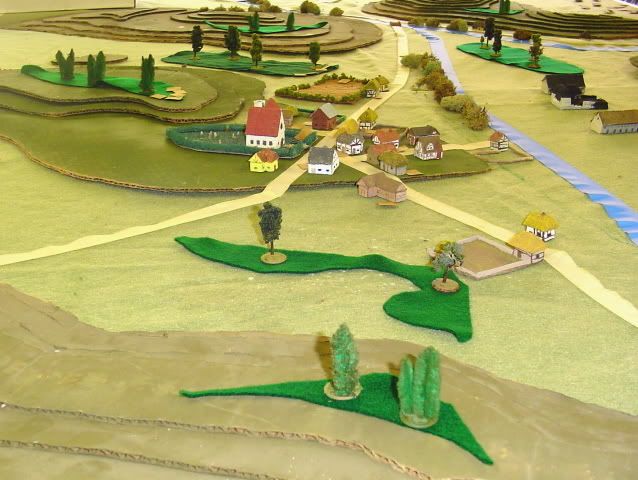
Here is the German CO's view of a long way to go against unknown Soviet defenses in a Barbarossa game. He's got about two companies under command. That's a big battle board, and his force feels pretty small to cover it all. I suppose he could just line his force up wheel-to-hub, but with so many unknowns, that is just not the way a reasonable player approaches things.
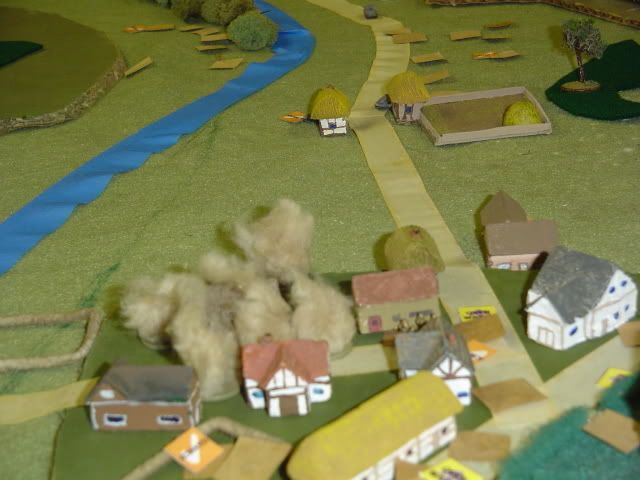
So he probes the defenses with his armor, and then softens things up with his mortars.

Now he's ready for his infantry company supported by a battery each of StuGs and PzJgrs to make a deliberate attack.
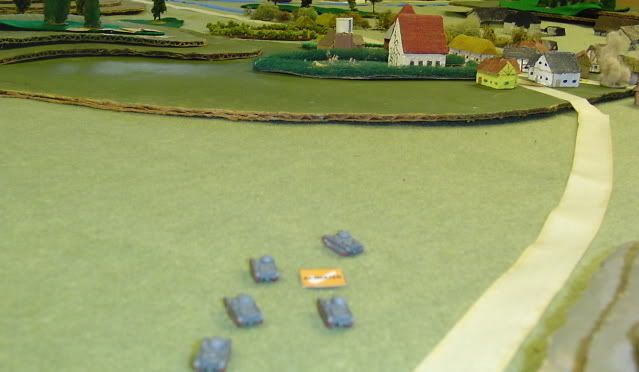
While a platoon of Pz Is breaks cover with a daring high-speed bid to turn the Soviets' flank.
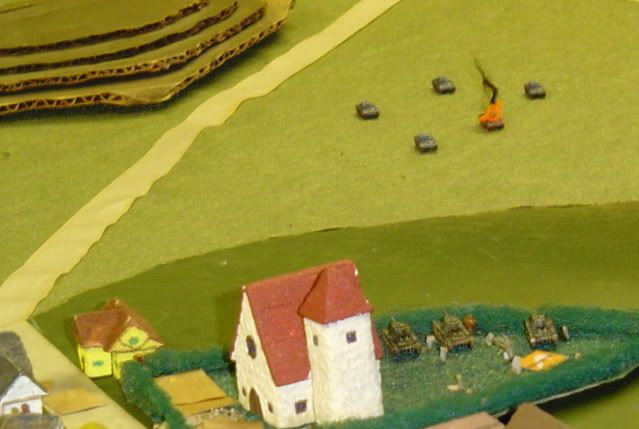
I think the Bolshoi actually ran a ballet entitled: "Happy is the comerade T-26 commander who catches the fascist vipers' Panzer 1s at range" ... or some such.
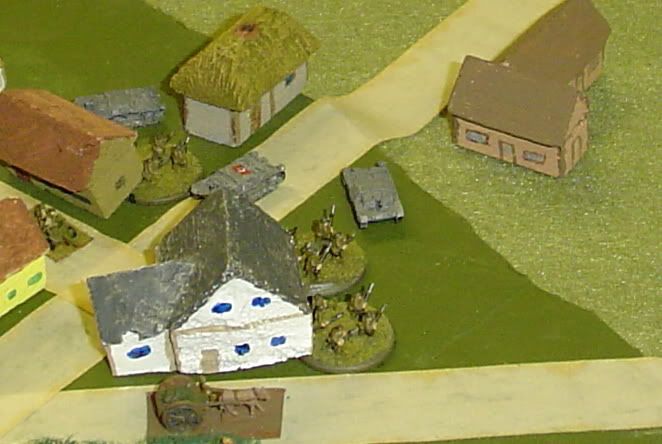
While in the village the fighting gets up close, and personal.
If you look at the later pictures you'll see that the area of battle was pretty small. But if you go back to the first picture you'll see that the area of maneuver was pretty big. Also, when you look at that big area, you see only a bunch of paper chits. Some of those chits are blanks. May be many, may be few ... you don't know. So the whole first part of the game is a fight for information. You are hesitant to show your true force. You want to develop the battlefield first ... to get some feel for what the other guy has, and where he has it, and maneuver yourself to hit him where he doesn't expect it, before you reveal your true strength.
Part of the parking-lot-of-tanks syndrome comes from an approach to gaming with relies too heavily on rolling dice against a chart. I line up my tanks, you line up yours, we reference your guns against my armor, throw a bucket of dice, and find out who wins. Can't be much else, if I know exactly what you have, and where you have it, and you know exactly what I have too. We'll face off, and if we are smart we'll each bring all of our firepower to bear at the same moment. Ehh, but not my style. I like uncertainty, the calculated risk, the daring thrust, and resisting the temptation to fire until the right moment. None of that happens when its a line of 25 Shermans against a line of 15 Panzers and let's start rolling the bones.
Its all in how you set up your game.
Posted: Wed Oct 10, 2007 3:24 pm
by BattlerBritain
I agree that the game setup is one of the key factors to prevent hub-to-hub engagements. But from experience a normal tabletop of around 6' x 4' can take about a battalion's worth of figures in 1:1 per side before things start getting like the M25 in rush hour.
If you use platoon scale for figures the number of figures seems to work out about the same, just that you model a larger formation, eg a regiment/divison.
Recently I've even tried a set of rules I came across a years back called "Not Quite Mechanised" which models at the Company scale (ie 1 model=1 Company) and gives set frontages for units equating to what was actually used. For 1/285th figures a scale of around 1":250m is used so that a divison with 2 regiments up each of 2 bns up covers a frontage of about 2 feet on the table. That's 6" per bn or 3" per Co. It's quite something to see a whole division lined up in formation but even at this scale units are on the edge of seeming densely packed.
One way of generating interesting scenarios I used at a games club in Cheltenham years back was to play a Campaign on a hex-map and when 2 sides came into contact declare a 'battle', setup the terrain as per the campaign map location, use paper chits as per Mk1 above to disguise the real-and-dummy units and then duke it out on the tabletop.
It proved to be a real bonus as neither player had a clue as to what they were up against until the units got to within spotting range. By then it was too late to do anything about it so the Campaign play became even more important.
We used the Korps Commander set of rules that use a platoon-ish scale for the tactical engagements. 1 foot on the table represented a Km so a tabletop battle was 3' x 3' tops. Quick to setup and quick to play. We used a copy of West End Games Air+Armor map to do the Campaign map and the Campaign was a bit like playing battleships: "Have you got anything at hex 1234?" - "Yep - lets do battle".
All good stuff.
Cheers,
Battler
Posted: Wed Oct 10, 2007 6:42 pm
by Peter_Fitz
When I first started wargaming with 1/72 plastic models in the mid-70s, my friend and I often had so many vehicles on the board that moving them around became an exercise similar to those puzzles where you have to move interlocking tiles around on a grid to make a picture. Then we discovered microarmour (Heroics & Ros in those days, we didn't know GHQ existed) and did pretty much the same thing with
hundreds of models on the table at once

Ah, happy days.
These days I'm a little more moderate, and seldom play anything bigger than one to two companies of infantry, with maybe a troop of tanks and a battery of guns in support. It's a lot more varied, and certainly a lot more challenging than the old "line 'em up and roll forward" games we used to play.
Apart from making for more interesting games, a huge advantage of sticking to small-scale actions is that it doesn't cost an arm and a leg to try out a new theatre of operations, and I can afford to be a bit more choosy about my paint-work because I'm not having to deal with umpteen models at a time.
Posted: Wed Oct 10, 2007 7:57 pm
by Cpl_Blakeman
Peter_Fitz wrote:Apart from making for more interesting games, a huge advantage of sticking to small-scale actions is that it doesn't cost an arm and a leg to try out a new theatre of operations, and I can afford to be a bit more choosy about my paint-work because I'm not having to deal with umpteen models at a time.
That is one of the best parts of smaller engagements.
Posted: Thu Oct 11, 2007 2:24 am
by Extra Crispy
I find that this "hub-to-hub" comes about because people field too many forces on the table, plain and simple. A unit may have a historical frontage of, say 24". So on a 4' wide table you put two units. But in real life a good amount of those troops would be busy watching the flanks - they are instead free to go anywhere.
I've adopted a nice 2/3 rule: spread end to end according to whatever command and control limits your rules use, your army should only cover 2/3 of the table width. That way there is always room to maneuver and everyone has flanks to worry about.
In fact, for Flames of War, I'm doing it in "half scale" using GHQ forces. I made half-scale rulers, making my 5x7 table effectively 10x14. Yet I'll be fielding a force that would normally be used on a 4x6 table. Welcome to the steppes of Russia!
Posted: Thu Oct 11, 2007 7:26 am
by jb
Most of the time I play "campaign" style,which makes "the Map" just as vital as the terrain that is be played with. When playing in this fashion the effect of those parking lot battles really just don't seem to happen. I've played a game one time where 2 US Army WWII combat commands were present in the "campaign". We never saw more than a company of Shermans on one table at a time( I take that back. If memeory recalls we did have one Battalion line up 2-1/2 companies towards the end).
The point about this is that when you have more area (i.e. the map sector) you will have a tendendcy to spread out , and only pile it on when the enemy wants to stop and fight. Then you still end up piling it on more on the map than the battlefield( you know pin him and maneuver around)
Posted: Fri Oct 12, 2007 7:18 pm
by kgpanzer
I focus on the scale of the game in reflect what size force is used....and also scenario.
1 tank is 1 tank and 1 inch is 100meters
Cheers
Anthony
Posted: Fri Oct 12, 2007 8:50 pm
by paul
I have played multiple ways and have found the best results where:
First, switching everything to centimeters. This kept the manuever aspect of the game intact.
Second, do not have all units come on at one time. Make it realistic. Obviously scouting is going to be done by an attacker. Use a typical recon force. Have the attacker identify where they want units to come in at the beginning and be allowed to make adjustments based on recon, of tcourse this slows down units arrival in those areas depending on far they are from the point.
Third, the defender is mostly likely not going to have the complete force on the board. Some level of reserve is going to exist. Use the same approach and have the defender identify where units are expected to come from before play starts. As play takes place they can adjust where a unit comes but also will also see a decrease on when units can arive depending on their entrance point.
This gives players additional units but not the feel of hub to hub.
Posted: Fri Oct 12, 2007 11:10 pm
by av8rmongo
Another technique that can be used to bring some maneuver back into the game is to think outside the box - if you will allow me to borrow a tired phrase. A year or so ago I was looking around for a new set of rules and I came across a set that had an interesting feature - you could give reinforcements a flanking order. Under this set of rules the flanking unit would essentially be moving off board and would hopefully arrive at the point on the side of the board when and where you wanted them thus surprising your enemy. Of course there was an abstracted mechanism for getting lost, being delayed, suffering casualties etc. while the unit was "off board".
I never actuially played the rules but it seemed to be a very clever way of defeating the natural tendency of treating the edge of the board as a protected flank. Rules rarely promote or even permit the idea that an "off board" flank is vulnerable. But some fights are 360 degree fights. We have off board artillery why not off board movement.
Unfortunately, I looked at so many different rulesets at the time I don't remember exactly which ones had this capability. If anyone else knows I would like to look at this set again to see what other nuggets it might have.
Paul






